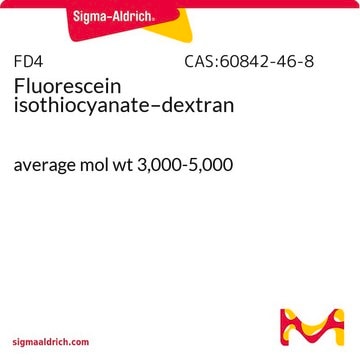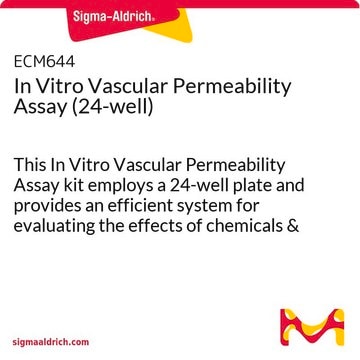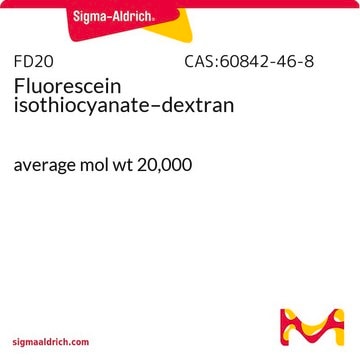53471
FITC-CM-Dextran
average mol wt 70,000
Synonym(s):
FITC-CM-Dextran 70, Fluorescein isothiocyanate–Carboxymethyl–Dextran
Sign Into View Organizational & Contract Pricing
All Photos(1)
About This Item
UNSPSC Code:
12352116
NACRES:
NA.32
Recommended Products
conjugate
FITC conjugate
Quality Level
form
powder or crystals
mol wt
average mol wt 70,000
composition
carboxymethyl content, 3-7%
extent of labeling
0.001-0.020 mol/mol FITC glucose
technique(s)
permeability assay: suitable
fluorescence
λex 493 nm; λem 517 nm±5 nm in 0.1 M Tris pH 8.0
Looking for similar products? Visit Product Comparison Guide
General description
FITC-CM-Dextran, also known as Fluorescein isothiocyanate–Carboxymethyl–Dextran, is an anionic fluorescent probe. The carboxyl group provides the negative charge, which improves the overall permeability of the molecule. It is supplied as a yellow powder that is freely soluble in water and electrolyte solutions. FITC-CM-Dextran is insoluble in most organic samples such as ethanol, methanol, acetone, and chloroform. FITC-CM-Dextran is manufactured by reacting selected dextran fractions with an activated carboxymethyl derivative in alkali, whereby O-carboxymethyl groups are introduced along the dextran chain.
Application
FITC-CM-dextran is used to study drug intake and delivery mechanisms in HeLa cell lines. FITC-CM-Dextran was chosen due to its high water solubility and negative charge. It is also a suitable molecule to be used in encapsulation studies for polymersomal drug delivery systems or Ps DDS. FITC-CM-Dextran is a biocompatible molecule used as a starting material in several pharmaceutical and diagnostic applications.
Storage Class Code
11 - Combustible Solids
WGK
WGK 3
Flash Point(F)
Not applicable
Flash Point(C)
Not applicable
Choose from one of the most recent versions:
Already Own This Product?
Find documentation for the products that you have recently purchased in the Document Library.
Customers Also Viewed
Chloe Martin et al.
International journal of pharmaceutics, 511(1), 570-578 (2016-07-28)
The need to develop a greater understanding of drug delivery systems has arisen through the development of alternative biological based therapeutics. Drug delivery systems need to adapt and respond to this increasing demand for cellular transportation of highly charged species.
Carrier and dose effects on the pharmacokinetics of T-0128, a camptothecin analogue-carboxymethyl dextran conjugate, in non-tumor- and tumor-bearing rats.
Harada M, Murata J, Sakamura Y, et al.
J. Controlled Release, 71, 71-86 (2001)
Yogy Simanjuntak et al.
PLoS pathogens, 16(5), e1008521-e1008521 (2020-05-12)
Zika virus (ZIKV) infection may lead to congenital microcephaly and pregnancy loss in pregnant women. In the context of pregnancy, folic acid (FA) supplementation may reduce the risk of abnormal pregnancy outcomes. Intriguingly, FA may have a beneficial effect on
Reduced diffusion of charge-modified, conformationally intact anionic Ficoll relative to neutral Ficoll across the rat glomerular filtration barrier in vivo.
Axelsson J, Sverrisson K, Rippe A, et al.
American Journal of Physiology: Renal Physiology, 301, F708-F712 (2011)
Giulia Paci et al.
eLife, 9 (2020-07-22)
Nucleocytoplasmic transport is tightly regulated by the nuclear pore complex (NPC). Among the thousands of molecules that cross the NPC, even very large (>15 nm) cargoes such as pathogens, mRNAs and pre-ribosomes can pass the NPC intact. For these cargoes
Our team of scientists has experience in all areas of research including Life Science, Material Science, Chemical Synthesis, Chromatography, Analytical and many others.
Contact Technical Service





